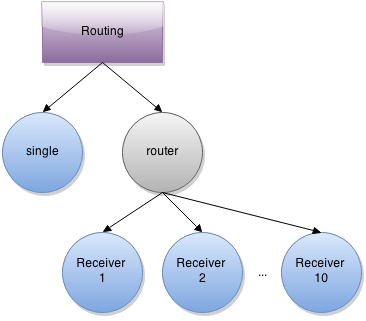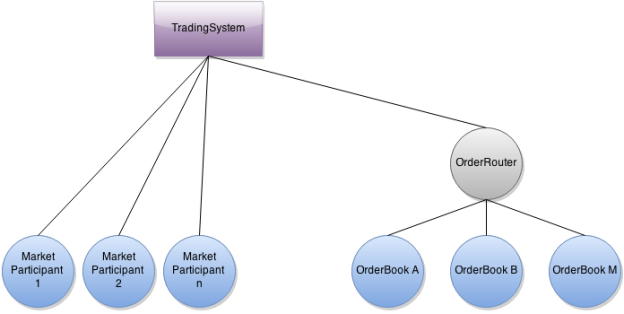Bootstrapping an Akka/Scala app
The basic setup of the application is simple. We use sbt as build tool. Therefore we need to create a build.sbt and add the required Akka artifacts as dependencies:
github:a43e4fe66eef085d352b
You can easily import the project into IntelliJ or use sbt plugins to generate project files for your preferred IDE:
Simple Message passing
After importing the project, we can implement our first ActorSystem. Its structure is shown below:

We want to create a single ActorSystem called routing having a Receiver Actor called single next to a RoundRobinRouter router with 10 children of type Receiver. We just need to instantiate the ActorSystem and create both the children single and router. The RoundRobinRouter creates its children by itself:
github:a6473c53024553c69836
The Receiver receives messages of type Message(String) and prints its message parameter. After receiving a message, we toggle the state of our receiver by using Akka’s become mechanism. So here is the definition of our Receiver actor:
github:d66c639e653e615ab697
As mentioned before, the actor simply prints the message. After it’s received a message it toggles its state from fastReceive to slowReceive and vice versa to simulate a more complex and time-consuming operation. Now that our system is complete, we can start sending messages to single and router:
github:214d6fb9001217963c8d
Right here we got our first problem. As you can see, expected that Akka preserves the order of the messages and that is true – as long as you don’t mix up sending messages by ActorRef andActorSelection. In this case the only guarantee is that all messages sent to an ActorRef will have a defined order and all messages sent by an ActorSelection have a defined order, too. But between these two mechanism of addressing messages, there is no guaranteed order. The last thing that we want to try is to shut down the ActorSystem after all messages have been processed. Because we’re in a multi-threaded environment, we cannot simply shutdown the system at the end of the main method. We could call system.shutdown() and then usesystem.awaitTermination() to wait until all currently active operations are finished, but we don’t know whether all messages have been processed. For this reason, Akka provides thegracefulShutdown mechanism: Using it means that a special message, the PoisonPill, is enqueued in the actors mailbox. All messages before the PoisonPill will be processed normally. When thePoisonPill is processed, the actor terminates and sends a Terminated message. After we’ve picked up all Terminated messages, we can shutdown the system safely:
github:4b26a588aa2cf64bd3cb
PingPong: Remote Messages
To try remoting in Akka, we have decided to play Actor ping-pong. The basic actor code is quite simple (simplified version):
github:d23018ebe12cac2f4b75
Based on an Akka Remote Hello-World example we wrote a “client” and a “server” application and configured them using Typesafe Config. One of the Actors just needs to kick off the game and then both ping-pong happily ever after. As the message protocol is very simple, the application is well-suited to measure Akka message latencies. Hence, we attached a timestamp to each message using System#nanoTime(). However, as stated in the Javadoc of System#nanoTime(), it is only suited for time measurements within a single JVM. So, instead of measuring only the latency from one actor to the other, we decided to measure roundtrip latency which allows us to use System#nanoTime() safely. To measure them, both messages are extended by a timestamp property and receive is changed accordingly:
github:078adca340429c8599d8
Our takeaways for this example:
- Actor distribution is easily possible but it is not immediately obvious how actors are distributed (i.e. we have to write a client and server application in our case)
- Time measurement in a distributed system requires some thought but we got away with a very simple solution to measure roundtrip latencies
Aside: Typesafe Config
We found that Typesafe config is noteworthy because it has an easy syntax, it is easy to use the Scala/Java API and it is Akka’s configuration mechanism. Typesafe config has a JSON-like syntax, called HOCON, that allows using different data types e.g. numbers, strings, arrays or nested “objects”. It also has built-in support for placeholder replacement. You can use it to override Akka defaults to tune your Akka application without changing a single line of code or to provide custom configuration for you own application. Here’s a structural excerpt from our application config:
github:71101ec51fe7c5c6fdc5
In the server application, we’re loading the configuration as follows:
github:1f68be598b89199a7e68
First, we are loading the default configuration into akkaConf and afterwards the dedicated server configuration into serverConf. Finally, we merge them into a single configuration called conf. When we’re reading a property from conf, we will get the one from ‘akka’ block in server section if it is present or the one from the root ‘akka’ block if not. The same way, Akka reads defaults from reference.conf and overrides them with properties from application.conf if such a file is present in the application’s classpath. If you want to know Akka’s default configuration you can take a look into reference.conf or into the Akka documentation.
The Trading App
Finally, we wanted to try a more involved example which needs more domain modeling and a more sophisticated messaging protocol. The example is inspired by the trading application based on the Akka trading performance example but we deviated in multiple aspects. In its current state, the trading application has some quirks, lacks a lot of features and it currently even lets money evaporate in certain circumstances…. That’s not nice, but we were able to prototype some concepts and it is a starting place for further experiments and enhancements, which we’ll discuss later in more detail.
The Domain
The purpose of the application is to simulate market participants who want to buy securities. Each participant can place orders: buyers place a bid, sellers place an ask. Bids and asks are matched in an orderbook (one per security) and a trade is made. The algorithm is based onAkka’s OrderBook.scala. It basically tries to match the highest bids with the lowest asks as long as possible. If an order cannot be fulfilled entirely, it is split. All participants’ goods are tracked in accounts: securities are kept in a depot, cash is kept in a deposit. Each account is charged as soon as an order is placed to avoid overcommitment. Upon fulfillment of an order the goods are credited.
Modeling an Akka app
The application consists of two actors which are coupled by a custom router:
- MarketParticipant: A market participant periodically places orders. It randomly decides whether to place a bid or an ask and also randomly decides on the offered price which is based on the current market price of the security including a random spread.
- OrderBook: There is one OrderBook actor for each security within the system to match trades. It takes orders and periodically matches them. Afterwards, it notifies the involvedMarketParticipants of the successful trade.
- OrderRouter: We decided to couple MarketParticipants and OrderBookss via a custom router. During startup the router creates OrderBook actors. When an order arrives, it decides whichOrderBook is responsible and forwards the order.

The diagram below shows the message flow of a trade through the system. The market participants place a bid and an ask through the OrderRouter which forwards the messages to the corresponding OrderBook for this security. It matches the orders and replies to both parties withBidResponse and AskResponse on success. They can in turn adjust their account balances accordingly.

Implementation
The simulation exists in two flavours: A single-node implementation which is bootstrapped inTradingSimulationApp and a distributed implementation which is implemented in RemoteClientAppwhich simulates the market and RemoteServerApp which simulates order books. To configure various aspects of the application such as the securities or number or market participants we used Typesafe Config. Wiring of the specific implementation is achieved with the Cake pattern.
Open Issues
We very able to try a lot of features of Akka such as become/unbecome, stashing, custom routers or remoting. However, the domain allows to expand the example application further in many different aspects which we’ll describe shortly below.
Domain
Regarding the domain we see the following areas of improvement:
- Losing money: The application holds money back in case an order is split or even evaporates it if the buying price differs from the bidding price. This hasn’t been much of an issue for our short-running simulation but it clearly is a showstopper for a real application. This issue can be solved in different ways. For example, we could cancel orders after a specific amount of time if they cannot be fulfilled or just reserve money instead of really charging the deposit.
- Acknowledgements: Acknowledgements of order receipts would allow for easier state tracking by market participants.
Technological
- Replication and fault tolerance: Currently, if an OrderBook actor fails, all open trades and the market valuation are lost. Using a dedicated supervisor node and a replication mechanism for each OrderBook would make the application far more reliable.
- Monitoring: The demo could include a monitoring mechanism to visualize different business metrics such as current market prices, number of open orders, or aggregated revenue and also technical metrics such as messages delivered, message latency and throughput of the system.
- Performance: The system is not tuned for performance at all. Based on the monitoring and different scenarios we could look into bottlenecks and tweak the system based on thevast configuration options of Akka.
Final Thoughts
Although our three lab days were very productive we barely scratched the surface of what’s possible with Akka. As you may have guessed from reading this blog post we struggled with some aspects but that’s a good sign: After all, we only learn something new by struggling first. We had a lot of fun in this lab and we’re looking forward to the next one to explore further aspects of Akka.
The sources of the demo can be found in the comSyto GitHub repo.